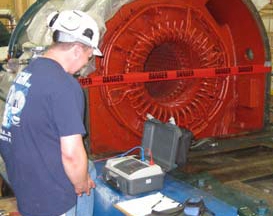Insulation Resistance (IR) Test
 The Insulation Resistance Test measures the integrity of the generator’s winding insulation, and therefore the likelihood of developing a ground. A test voltage is applied to the generator and the current flow required to maintain that voltage is measured over a period of time (typically one minute). In simplest terms, the less current flow, the higher the resistance value, and the better the insulation.
The Insulation Resistance Test measures the integrity of the generator’s winding insulation, and therefore the likelihood of developing a ground. A test voltage is applied to the generator and the current flow required to maintain that voltage is measured over a period of time (typically one minute). In simplest terms, the less current flow, the higher the resistance value, and the better the insulation.
An IR test should be performed immediately following any type of event that is suspected of over-stressing an insulation system, prior to the generator being placed back into service. This is the first test that should be performed. The results will indicate the ability of the insulation system to withstand any more searching and/or strenuous testing. The IR test also measures the effect of contamination from water, oil, carbon, and other such undesirables. If a separate high voltage proof test is performed, an IR test should be performed both before and after the proof test. This in order to assure that the proof test itself has not compromised the insulation.
The Insulation Resistance test must be performed by a well trained and experienced technician. Incorrect procedures can materially affect the results. The test should be performed to IEEE Standard 43-2000 (R2006), using a late model Megger brand machine such as Model MIT1025, or comparable. It is best practice to test at the main and neutral leads of the stator, as close to the windings as possible. Stator slot RTD’s should be disconnected from the terminal board and grounded. Surge capacitors should be disconnected. The water or oil should be drained and completely evacuated from liquid inner-cooled windings, typically by vacuum-processing. Stator windings should be tested one phase at a time, with the other two phases grounded. In this manner, the windings are stressed both phase-to-ground and phase-to-phase.
The results should be interpreted by an experienced technician. Your final report should reflect that environmental conditions and even the age and configuration of the machine were taken into consideration.
If you have any questions concerning the application of this test or the interpretation of the results, please contact Mr. Turbine.
